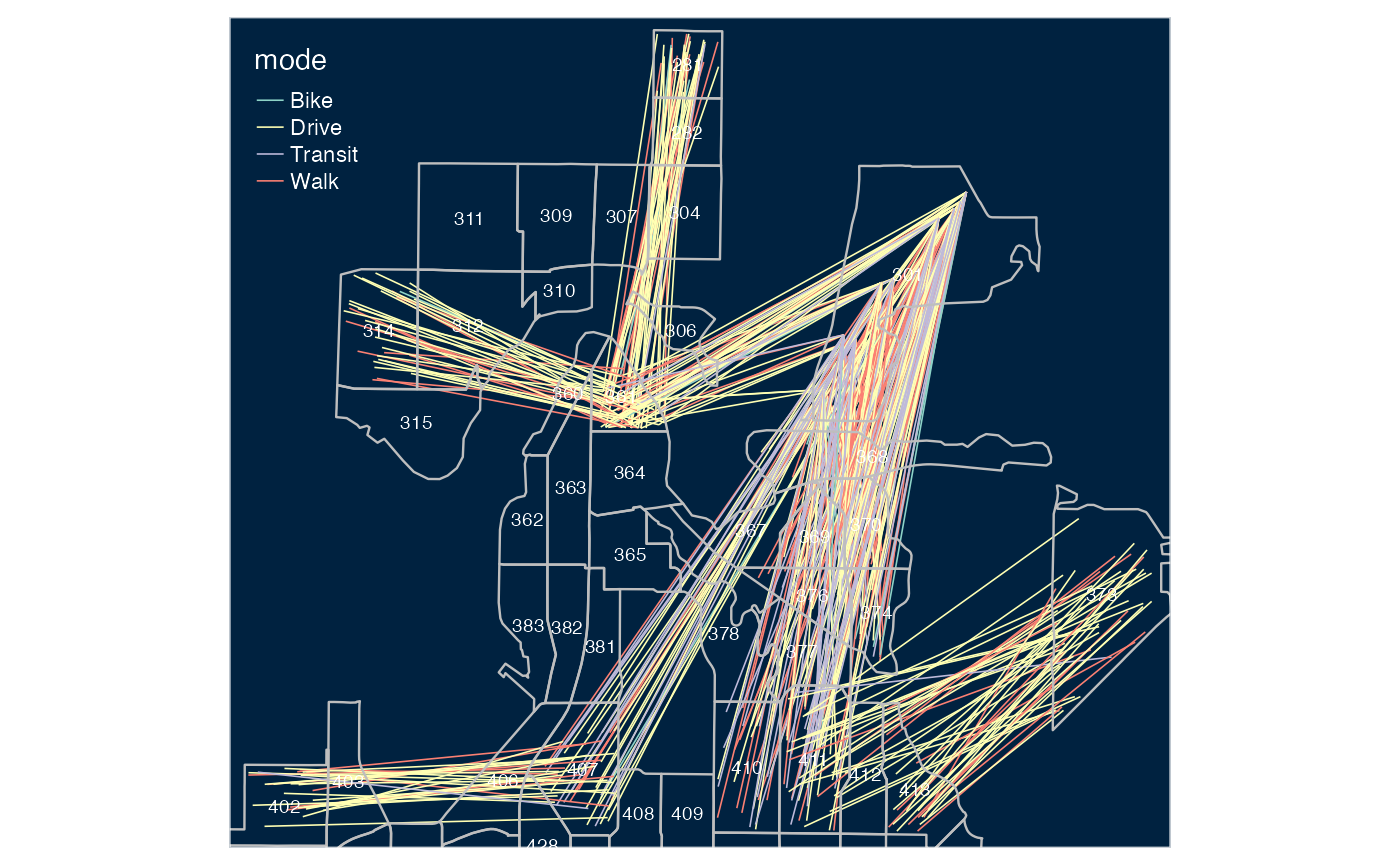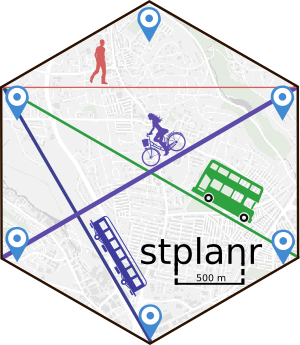Getting started
Installing R
To generate new scenario files to import into A/B Street with the
abstr R package, you need to have installed a stable
version of Rstudio
and R.
Installing A/B Street
Install the latest
build of A/B Street for your platform. Or if you prefer, build from
source, but it’s not necessary for any integration with the
abstr package.
Using abstr
Load the package as follows:
The input datasets include sf objects representing
buildings, origin-destination (OD) data represented as desire lines and
administrative zones representing the areas within which trips in the
desire lines start and end. With the exception of OD data, each of the
input datasets is readily available for most cities. The input datasets
are illustrated in the plots below, which show example data shipped in
the package, taken from the Seattle, U.S.
library(abstr)
library(tmap) # for map making
tm_shape(montlake_zones) + tm_polygons(col = "grey") +
tm_shape(montlake_buildings) + tm_polygons(col = "blue") +
tm_style("classic")
Example data that can be used as an input by functions in abstr to generate trip-level scenarios that can be imported by A/B Street.
The map above is a graphical representation of the Montlake
residential neighborhood in central Seattle, Washington. Here,
montlake_zones represents neighborhood residential zones
declared by Seattle local government and montlake_buildings
being the accumulation of buildings listed in
OpenStreetMap
The final piece of the abstr puzzle is OD data.
head(montlake_od)
#> o_id d_id Drive Transit Bike Walk
#> 1 281 361 23 1 2 14
#> 2 282 361 37 4 0 11
#> 3 282 369 14 3 0 8
#> 4 301 361 27 4 3 15
#> 5 301 368 6 2 1 16
#> 6 301 369 14 2 0 13In this example, the first two columns correspond to the origin and destination zones in Montlake, with the subsequent columns representing the transport mode share between these zones.
Let’s combine each of the elements outlined above, the zone, building
and OD data. We do this using the ab_scenario() function in
the abstr package, which generates a data frame
representing tavel between the montlake_buildings. While
the OD data contains information on origin and destination zone,
ab_scenario() ‘disaggregates’ the data and randomly selects
building within each origin and destination zone to simulate travel at
the individual level, as illustrated in the chunk below which uses only
a sample of the montlake_od data, showing travel between
three pairs of zones, to illustrate the process:
set.seed(42)
montlake_od_minimal = subset(montlake_od, o_id == "373" |o_id == "402" | o_id == "281" | o_id == "588" | o_id == "301" | o_id == "314")
output_sf = ab_scenario(
od = montlake_od_minimal,
zones = montlake_zones,
zones_d = NULL,
origin_buildings = montlake_buildings,
destination_buildings = montlake_buildings,
pop_var = 3,
time_fun = ab_time_normal,
output = "sf",
modes = c("Walk", "Bike", "Drive", "Transit")
)The output_sf object created above can be further
transformed to match A/B
Street’s schema and visualised in A/B Street, or visualised in R
(using the tmap package in the code chunk below):
tm_shape(output_sf) + tmap::tm_lines(col = "mode", lwd = .8, lwd.legeld.col = "black") +
tm_shape(montlake_zones) + tmap::tm_borders(lwd = 1.2, col = "gray") +
tm_text("id", size = 0.6) +
tm_style("cobalt")
#> [tm_lines()] Argument `lwd.legeld.col` unknown.
Each line in the plot above represents a single trip, with the color representing each transport mode. Moreover, each trip is configured with an associated departure time, that can be represented in A/B Street.
The ab_save and ab_json functions conclude
the abstr workflow by outputting a local JSON file,
matching the A/B
Street’s schema.
output_json = ab_json(output_sf, time_fun = ab_time_normal, scenario_name = "Montlake Example")
ab_save(output_json, f = "montlake_scenarios.json")Let’s see what is in the file:
file.edit("ab_scenario.json")The first trip schedule should look something like this, matching A/B Street’s schema.
Importing scenario files into A/B Street
After generating a montlake_scenario.json, you can
import and simulate it as follows.
- Run A/B Street, and choose “Sandbox” on the title screen.
- If necessary, change the map to the Montlake district of Seattle, or whichever map your JSON scenario covers.
- Change the scenario from the default “weekday” pattern. Choose
“import JSON scenario,” then select your
montlake_scenario.jsonfile.
After you successfully import this file once, it will be available in
the list of scenarios, under the “Montlake Example” name, or whatever
name specified by the JSON file.
Projects supporting abstr
Several open source R packages enabled the creation of
abstr.
These include:
Context
To further understand the methods and motivations behind
abstr, it helps to have some context. The package builds on
the ecosystem of open source software for geospatial data (FOSS4G) and packages such as stplanr for
working with transport data in R. stplanr was developed to
support development of the the Propensity to Cycle Tool (PCT), an open source transport planning
system for England and Wales. The PCT package enables access to the
data generated by the PCT project, plus scenario of change modeling (not
forecasting) at the origin-destination level, which can provide results
at regions, local, route and route network levels.

The PCT provides a range of deterministic scenarios of change, such
as go_dutch (where cycling levels matches that of the
Netherlands), gender_eq (where there is equal levels of
cycling among Female and Males) and gov_target (where
cycling levels reflect that of UK government current targets). An
academic paper on
the PCT provides further detail on the motivations for and methods
underlying the project. In 2018 the beasty stplanr
(sustainable transport planning) package and R journal article
came on the scene, and further provided functions for solving common
problems in transport planning and modeling, as well as advocating a
transparency in tool usage within the transport planning paradigm.
Finally, on the R side, in 2021 the od package was
released which provided functions for working with origin-destination
data. A central focus in all of the packages and papers mentioned above
is to provide open access transport tools to support data driven
transport policies based on an objective and transparent evidence
base.
For more on the history motivating the development of the
abstr package see the pct_to_abstr
vignette
